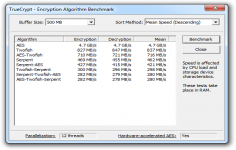 TrueCrypt 5.1
TrueCrypt 5.1
TrueCrypt Foundation - (Open Source)
Encrypting a USB key or a whole disk or even creating virtual encrypted disks, all these are possible with TrueCrypt.
TrueCrypt is a solution for storing encrypted information, allowing to create encrypted virtual disks. When mounted, the media appear in Explorer as a local disk. The application is also able to encrypt an entire volume or partition, which is very useful if there are sensitive information on the USB drive, for example. The encrypted volume is seen by the system as a typical hard and has all the features, being necessary only to enter the password associated with the volume at the time of "montage".
The software also includes hardware acceleration for encryption and decryption of AES algorithm. Enabled by default , this small revolution concerns only the recent Intel processors with the necessary capabilities : Intel Core i7- 980X , Intel Core i7 -970 , Intel Core i5- 650, Intel Core i5- 655K , Intel Core i5- 660, Intel Core i5 -661 , Intel Core i5 -670 , Intel Core i5 -680 and more, the speed of encoding and decoding being up to 8 times faster.
A volume can be mounted directly under Windows subject to provide the correct password. It is possible to create partitions and storage devices encrypted on the hard disk sectors with 4096, 2048 or 1024 bytes.
Many standard algorithms are supported by TrueCrypt, such as AES-256, Blowfish, CAST5, Serpent, Triple DES, and Twofish.
- Title:
- TrueCrypt 5.1
- File Size:
- 2.5 MB
- Requirements:
- Windows 2000 / XP / Vista / Windows7 / XP64 / Vista64 / Windows7 64 / Windows8 / Windows8 64
- Language:
- en-us
- License:
- Open Source
- Date Added:
- 10 Mar 2008
- Publisher:
- TrueCrypt Foundation
- Homepage:
- http://www.truecrypt.org
- MD5 Checksum:
- DF8385F648245AD4BA287089F5EA2B70
New features:
* Support for hibernation on computers where the system partition is encrypted (previous versions of TrueCrypt prevented the system from hibernating when the system partition was encrypted). (Windows Vista/XP/2008/2003)
* Ability to mount a partition that is within the key scope of system encryption without pre-boot authentication (for example, a partition located on the encrypted system drive of another operating system that is not running). (Windows Vista/XP/2008/2003)
Note: This can be useful e.g. when there is a need to back up or repair an operating system encrypted by TrueCrypt (from within another operating system).
* Command line options for creating new volumes. (Linux and Mac OS X)
Improvements:
* Increased speed of AES encryption/decryption (depending on the hardware platform, by 30-90%). (Windows)
* Faster booting when the system partition is encrypted. (Windows Vista/XP/2008/2003)
* When the system partition/drive is encrypted, the TrueCrypt Boot Loader is now stored in a compressed form and is, therefore, smaller. If a non-cascade encryption algorithm is used (i.e., AES, Serpent, or Twofish), the TrueCrypt Boot Loader is now small enough so that a backup of the TrueCrypt Boot Loader can be (and is) stored in first drive cylinder. Whenever the TrueCrypt Boot Loader is damaged, its backup copy is run automatically instead.
As a result of this improvement, the following problem will no longer occur: Certain inappropriately designed activation software (used for activation of some third-party software) writes data to the first drive cylinder, thus damaging the TrueCrypt Boot Loader. The affected users had to use the TrueCrypt Rescue Disk to repair the TrueCrypt Boot Loader. This will no longer be necessary after upgrading to this version of TrueCrypt (provided that the system partition/drive is encrypted using a non-cascade encryption algorithm, i.e., AES, Serpent, or Twofish).
Note: If your system partition/drive is currently encrypted using a non-cascade encryption algorithm (i.e., AES, Serpent, or Twofish), a backup copy of the TrueCrypt Boot Loader will be automatically stored in the first drive cylinder when you upgrade to this version of TrueCrypt.
* The minimum memory requirements for the TrueCrypt Boot Loader have been reduced from 42 KB to 27 KB (twenty-seven kilobytes). This allows users to encrypt system partitions/drives on computers where the BIOS reserves a large amount of memory. (Windows Vista/XP/2008/2003)
* Many other minor improvements. (Windows, Mac OS X, and Linux)
Resolved incompatibilities:
* On some computers, when performing the system encryption pretest, Windows failed to display the log-on screen. This will no longer occur. (Windows Vista/XP/2008/2003)
Bug fixes:
* On some systems, drive letters were not correctly assigned to newly mounted non-system volumes. This will no longer occur. (Windows)
* Many other minor bug fixes. (Windows, Mac OS X, and Linux)
Related software
2.2/5 from 179 users


